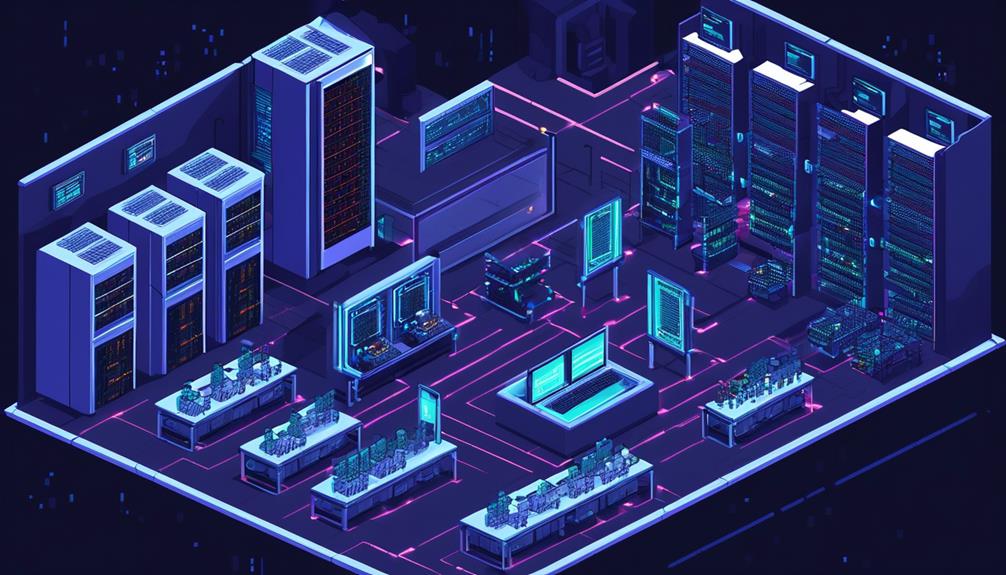Data center cooling optimization is a critical aspect of managing the ever-increasing demand for efficient and sustainable data centers. Utilizing artificial intelligence (AI) for this purpose has gained significant attention due to its potential to revolutionize cooling systems.
By employing sophisticated AI algorithms, data center operators can achieve real-time adjustments of cooling units based on workload, resulting in reduced energy consumption and improved overall efficiency. Moreover, AI-based solutions offer the capability to detect sub-optimal equipment performance and enable predictive maintenance, leading to enhanced performance and cost savings.
In this discussion, we will explore the intricacies of AI in data center cooling optimization, its benefits over traditional methods, the potential for energy efficiency improvement, as well as its role in predictive maintenance and early fault detection. Additionally, we will delve into the future prospects of AI in data center cooling and examine real-world examples of AI-optimized cooling solutions that have already made a significant impact in the industry.
Key Takeaways
- AI enables real-time optimization of data center cooling environments, leading to improved efficiency and reduced energy consumption.
- AI algorithms continuously monitor and evaluate cooling units, quickly detecting and notifying teams of any suboptimal performance or cooling issues.
- AI-based cooling systems result in significant cost savings by reducing excessive cooling costs and minimizing downtime and repair costs.
- Collaboration between industry leaders and technology providers is driving the adoption of AI-based cooling solutions in data centers.
Understanding AI in Data Center Cooling
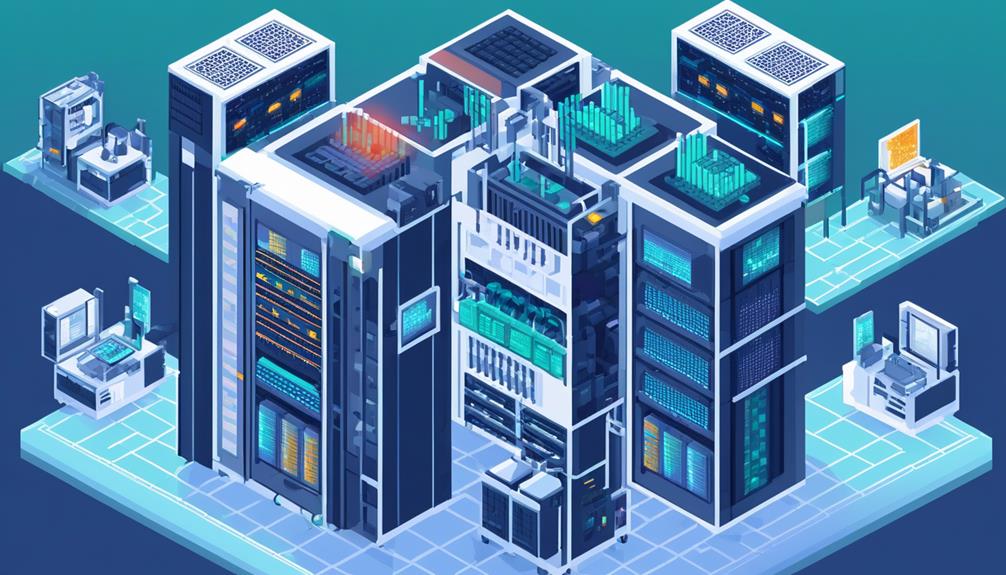
Understanding the impact of AI on data center cooling is crucial for optimizing performance, reducing energy consumption, and improving operational efficiency. AI allows for dynamic optimization of data center environments in real time, leading to improved performance, cost, and operation. By leveraging AI, intuitive management of cooling units can be achieved, matching the load they are serving and reducing energy consumption while enhancing efficiency. This intelligent management system is capable of continuously monitoring and evaluating the cooling units without the need for breaks, filling gaps that are traditionally difficult to fill with manual labor.
Furthermore, AI plays a significant role in identifying sub-optimal equipment performance through power monitoring. With the ability to analyze real-time power data, AI algorithms can identify inefficiencies and alert operators to potential issues before they result in critical failures. This predictive maintenance approach not only saves time and costs associated with reactive maintenance but also improves overall system reliability.
Moreover, the potential for sustainability with AI in data center cooling aligns with the broader conversation about using AI to address environmental challenges, such as reducing global greenhouse gas emissions. By optimizing cooling operations, AI can significantly reduce energy consumption, leading to a smaller carbon footprint for data centers.
Benefits of AI-Optimized Cooling Systems
AI-optimized cooling systems offer significant benefits in terms of cost savings, energy efficiency, and operational efficiency in data centers. These systems ensure proper temperature maintenance without excessive cooling costs. By considering outside temperature and humidity, AI algorithms can optimize the operation of the data center cooling system, resulting in cost savings and energy efficiency.
One of the key advantages of AI-optimized cooling systems is their ability to constantly monitor the data center's cooling infrastructure. AI algorithms can quickly detect and notify teams of any cooling issues, enabling prompt action to be taken to avoid potential downtime. This improves operational efficiency and reduces the risk of equipment failure.
AI also allows teams to identify sub-optimal performance of cooling equipment through power monitoring. By analyzing power consumption patterns, AI algorithms can detect anomalies and predict potential failures before they occur. This facilitates proactive maintenance, reducing downtime, and minimizing repair and replacement costs.
Furthermore, the benefits of predictive maintenance extend beyond cooling equipment. AI algorithms can analyze data from various components of the data center, such as servers, storage, and networking equipment, to identify potential issues and optimize their performance. This comprehensive approach enhances overall operational efficiency and reduces costs.
AI Vs. Traditional Cooling Methods
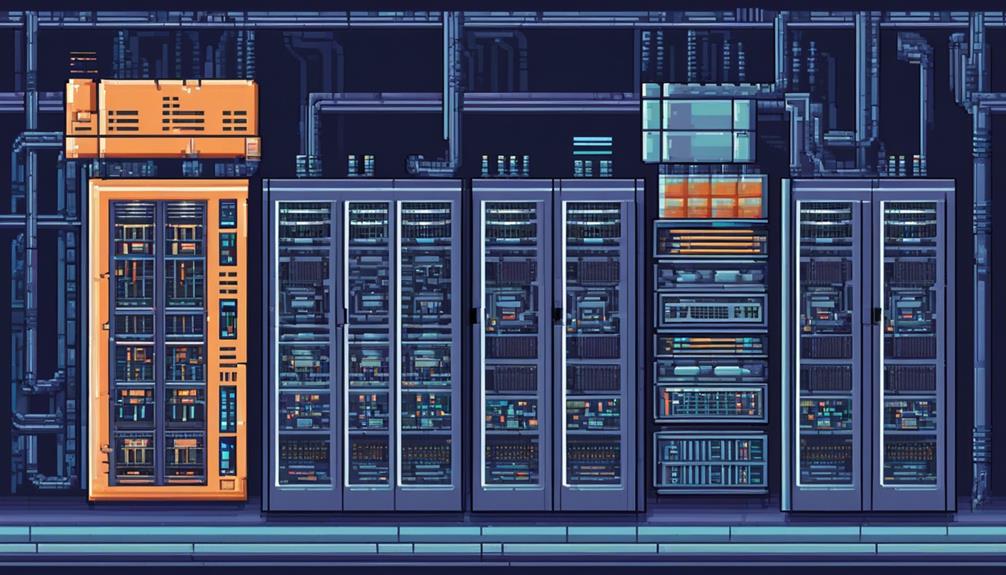
With its ability to dynamically optimize data center environments in real-time, AI surpasses traditional cooling methods in terms of performance and cost efficiency. Here are some key reasons why AI has the upper hand:
- Improved Energy Efficiency: Traditional cooling methods often rely on fixed speed and energy levels, resulting in inefficiencies when the load varies across the data center. In contrast, AI enables the reduction of speed in lightly loaded cooling units and increased effort in heavily loaded units. This adaptive approach ensures optimal efficiency that traditional methods struggle to achieve.
- Real-time Load Balancing: AI allows for the real-time balancing of cooling units to match the specific load in different areas of the data center. By continuously monitoring and analyzing the cooling requirements, AI can dynamically allocate resources, addressing the cooling inefficiencies experienced by traditional methods.
- Intuitive Management: AI provides real-time monitoring and insights into the data center's cooling infrastructure. This level of visibility and control enables intuitive management of cooling units, ensuring they operate at their peak efficiency. Traditional methods lack this capability, leading to suboptimal performance and higher energy consumption.
- Cost Savings: AI-optimized cooling systems can result in significant cost savings. By dynamically adjusting cooling resources based on real-time data, AI minimizes energy wastage and reduces operational expenses. Traditional methods, on the other hand, often rely on fixed cooling settings, leading to higher energy consumption and unnecessary costs.
Improving Energy Efficiency With AI
Improving energy efficiency in data centers is a critical concern. AI-based cooling algorithms offer promising solutions. By dynamically optimizing data center environments in real time, AI can reduce energy consumption and improve overall performance.
AI allows for intuitive management of cooling units. It adjusts their speed and effort to match the load they are serving. This reduces cooling inefficiencies and ensures optimal efficiency.
AI-Based Cooling Algorithms
AI-based cooling algorithms are revolutionizing data center environments by dynamically optimizing performance, cost, and operation in real time. These algorithms enable the intuitive management of cooling units, matching their load and reducing energy consumption and costs.
By balancing the act of cooling units, AI-based algorithms maximize efficiency by reducing the speed of lightly loaded units and increasing the effort of heavily loaded units. With constant monitoring and quick notification of cooling issues, AI ensures proper temperature maintenance without excessive cooling costs.
The collaboration between industry leaders and technology providers is driving the development and adoption of AI-based cooling solutions in data centers. This advancement in data center cooling optimization is enhancing energy efficiency and paving the way for more sustainable practices in the industry.
Energy Consumption Reduction
The integration of AI in data center cooling algorithms has led to significant advancements in energy consumption reduction and improved energy efficiency. By leveraging AI, data center operators can optimize their cooling systems in real time, resulting in reduced energy usage and cost savings. AI enables the management of cooling units based on the specific load they are serving, allowing for dynamic adjustments to minimize energy consumption. By reducing the speed of lightly loaded units and increasing the effort of heavily loaded units, AI-driven algorithms can optimize energy usage without compromising temperature maintenance. Additionally, AI enables the balancing act of cooling units to obtain optimal efficiency, ensuring proper temperature control without incurring excessive cooling costs. The implementation of AI-driven HVAC systems in data centers has proven to be an effective strategy for reducing energy consumption and improving overall energy efficiency.
| Benefits of AI for Energy Consumption Reduction in Data Centers |
|---|
| Dynamic optimization of cooling systems |
| Intuitive management of cooling units |
| Reduction of energy usage and cost savings |
| Efficient balancing of cooling units |
| Improved overall energy efficiency |
The integration of AI in data center cooling algorithms has led to significant advancements in energy consumption reduction and improved energy efficiency. By leveraging AI, data center operators can optimize their cooling systems in real time, resulting in reduced energy usage and cost savings. AI enables the management of cooling units based on the specific load they are serving, allowing for dynamic adjustments to minimize energy consumption. By reducing the speed of lightly loaded units and increasing the effort of heavily loaded units, AI-driven algorithms can optimize energy usage without compromising temperature maintenance. Additionally, AI enables the balancing act of cooling units to obtain optimal efficiency, ensuring proper temperature control without incurring excessive cooling costs. The implementation of AI-driven HVAC systems in data centers has proven to be an effective strategy for reducing energy consumption and improving overall energy efficiency.
| Benefits of AI for Energy Consumption Reduction in Data Centers |
|---|
| Dynamic optimization of cooling systems |
| Intuitive management of cooling units |
| Reduction of energy usage and cost savings |
| Efficient balancing of cooling units |
| Improved overall energy efficiency |
Predictive Maintenance for Cooling Systems
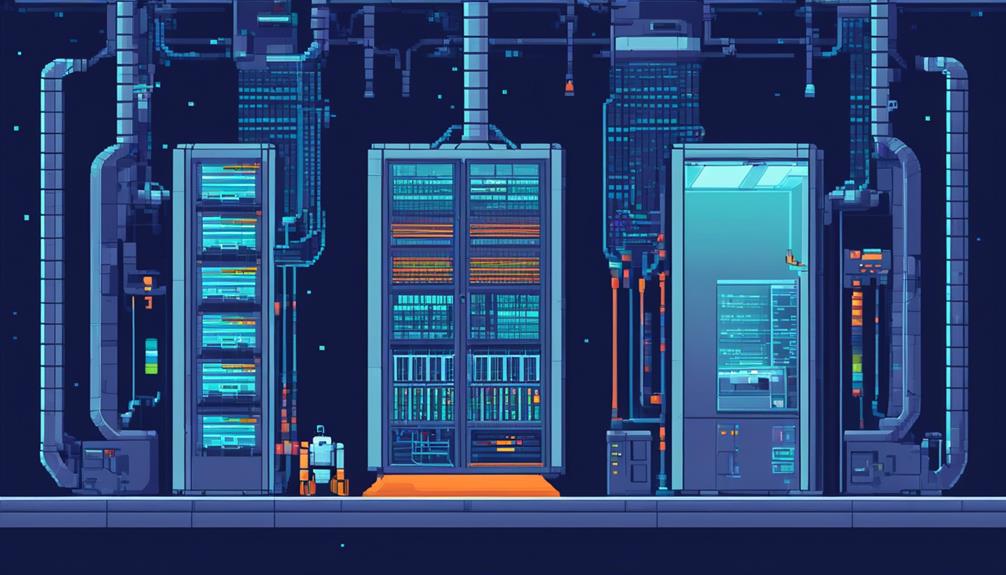
Predictive Maintenance for Cooling Systems plays a critical role in enhancing the operational efficiency of data centers.
By utilizing AI technology, it enables the early detection and prevention of faults in cooling units.
This proactive approach not only minimizes downtime but also optimizes energy efficiency, leading to substantial cost savings and improved performance.
Fault Detection and Prevention
Utilizing advanced machine learning algorithms, fault detection and prevention systems for cooling systems in data centers employ real-time data analysis to proactively identify potential issues and optimize performance. These AI-driven systems continuously monitor cooling system performance, allowing for seamless integration and management of HVAC systems in data centers.
By detecting anomalies and addressing potential issues before they occur, AI-based predictive maintenance reduces downtime and optimizes repair costs. This not only ensures efficient cooling but also leads to significant energy savings for data centers.
The benefits of fault detection and prevention systems in data center cooling include improved reliability, enhanced energy efficiency, reduced operational costs, and increased overall system performance. By leveraging AI technology, data centers can optimize their cooling systems to achieve maximum efficiency and reliability, ensuring the smooth operation of critical infrastructure.
Energy Efficiency Optimization
Optimizing energy efficiency in data center cooling systems through predictive maintenance for HVAC systems is crucial for ensuring optimal performance and reducing operational costs. AI-driven HVAC systems utilize AI algorithms to proactively detect anomalies or performance drops, extending the lifespan of the HVAC system and optimizing repair costs. By dynamically adjusting settings based on sensor readings, these systems ensure efficient cooling and significant energy savings. Data center operators benefit from seamless integration and management of HVAC systems through remote monitoring, real-time updates, and intuitive interaction via voice and app-based controls. AI-driven HVAC systems also analyze real-time air quality data to balance air quality for equipment and operational efficiency, improving the overall air quality in data centers. Additionally, AI revolutionizes temperature and humidity control by adapting and optimizing HVAC operations in real-time, further enhancing energy efficiency.
| Key Benefits | Key Features |
|---|---|
| – Optimal performance and reduced operational costs | – Proactive anomaly detection |
| – Extended HVAC lifespan and optimized repair costs | – Dynamic adjustment based on sensor readings |
| – Significant energy savings | – Seamless integration and management |
| – Improved air quality in data centers | – Real-time air quality analysis |
| – Adaptive temperature and humidity control | – Remote monitoring and real-time updates |
Enhancing AIr Quality in Data Centers With AI
Enhancing air quality in data centers is a critical objective that can be achieved through the implementation of AI-driven HVAC systems. These systems optimize operations in real-time, ensuring efficient cooling and reducing energy use. By analyzing real-time air quality data, AI algorithms can adjust HVAC operations to maintain clean and safe air in data centers.
The advantages of enhancing air quality in data centers with AI-driven HVAC systems are numerous. Here are some key benefits:
- Improved Health and Safety: AI algorithms continuously monitor air quality parameters such as temperature, humidity, and particulate matter levels. By maintaining optimal air quality, these systems create a healthier and safer environment for both the equipment and personnel working in the data center.
- Energy Efficiency: AI-powered HVAC systems revolutionize temperature and humidity control, leading to efficient cooling and significant energy savings. By optimizing operations in real-time, these systems can dynamically adjust cooling levels based on actual demand, minimizing energy consumption and reducing carbon footprint.
- Predictive Maintenance: AI-driven HVAC systems enable predictive maintenance, which reduces downtimes and optimizes repair costs. By analyzing real-time data and identifying potential issues before they escalate, these systems can schedule maintenance activities proactively, ensuring the continuous operation of critical equipment.
- Smart Integration: AI-powered HVAC systems seamlessly integrate into smart, interconnected ecosystems. This integration allows for intuitive interaction and agile responses, enabling data center operators to have real-time insights into the HVAC system's performance and make informed decisions.
Remote Monitoring and Control With AI
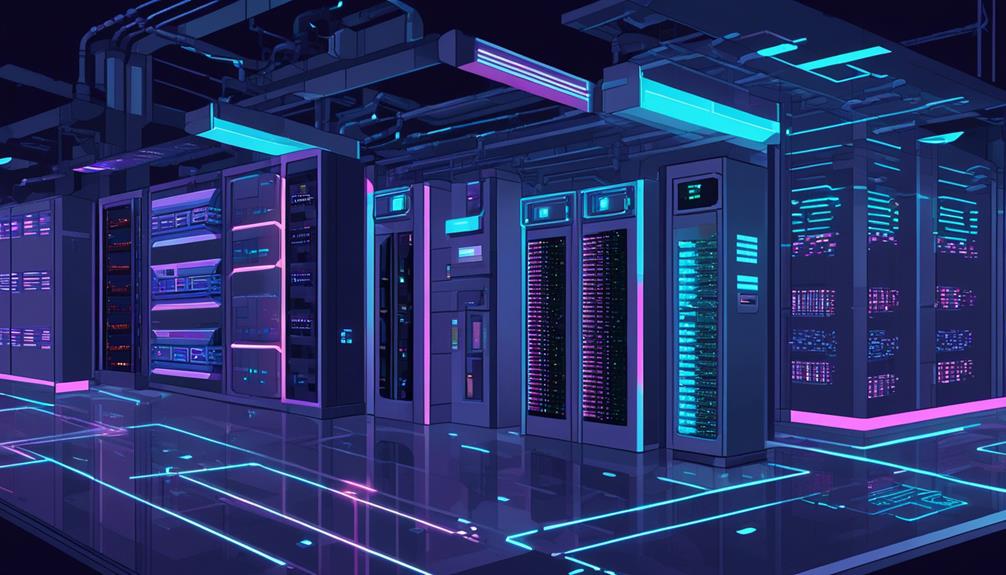
Remote monitoring and control with AI enables real-time temperature adjustments and energy-efficient cooling strategies in data centers. By utilizing AI algorithms, cooling units can dynamically adapt to the load they are serving, optimizing energy consumption and cooling efficiency.
This advanced technology ensures constant monitoring and quick notification of cooling issues, allowing data center operators to maintain optimal conditions for their equipment while minimizing energy waste.
Real-Time Temperature Adjustments
Real-Time Temperature Adjustments, enabled by AI-driven remote monitoring and control, revolutionize the optimization of cooling units in data centers. This advanced technology allows for dynamic adjustments to be made based on real-time data, ensuring that cooling units are operating at optimal levels.
Here are four key benefits of real-time temperature adjustments in data center cooling optimization:
- Intuitive management: AI enables cooling units to match the load they are serving, reducing unnecessary cooling costs.
- Optimal efficiency: Real-time adjustments can reduce the speed of lightly loaded units and increase the effort of heavily loaded units, resulting in improved overall efficiency.
- Enhanced monitoring: AI facilitates constant monitoring and quick notification of cooling issues, allowing for timely intervention and improved data center operations.
- Energy savings: AI-driven temperature adjustments result in significant energy savings, leading to reduced operational costs and a more sustainable data center environment.
With real-time temperature adjustments, data centers can achieve greater efficiency, cost savings, and improved performance in their cooling systems.
Energy-Efficient Cooling Strategies
Energy-efficient cooling strategies in data centers can be achieved through the implementation of remote monitoring and control using AI technology.
AI enables dynamic optimization of data center environments in real time, allowing for the intuitive management of cooling units to match the load they are serving. By reducing the speed of lightly loaded units and increasing the effort of heavily loaded units, AI enables the balancing act of cooling units to obtain optimal efficiency.
Additionally, AI enables constant monitoring and quick notification of cooling issues, ensuring that energy is not wasted and potential problems are addressed promptly.
This remote monitoring and control with AI technology provides data centers with the ability to optimize energy consumption and cooling performance, leading to significant energy savings and improved overall efficiency.
AI for Early Fault Detection in Cooling Systems
AI-enabled early fault detection in cooling systems plays a crucial role in preventing costly downtime and equipment failures. By leveraging machine learning algorithms to analyze data from sensors, AI can identify patterns that indicate potential faults in cooling systems. This allows for proactive maintenance and optimization, as potential issues in cooling units can be predicted and alerted in advance. The benefits of early fault detection through AI extend beyond avoiding unexpected failures; it also improves overall cooling system reliability.
The significance of AI-based fault detection systems in data center cooling optimization cannot be overstated. Here are four compelling reasons why:
- Cost Savings: Early fault detection helps prevent costly downtime, which can result in lost revenue and reputation damage. By addressing potential issues before they escalate, AI enables timely repairs and reduces the need for emergency maintenance, ultimately saving significant costs.
- Operational Efficiency: AI-driven fault detection systems provide real-time insights into the performance of cooling systems. This allows data center operators to optimize their operations by identifying areas for improvement, such as adjusting cooling settings or addressing inefficiencies.
- Enhanced Equipment Lifespan: Identifying faults in cooling systems at an early stage enables prompt repairs and maintenance. This proactive approach helps extend the lifespan of cooling equipment, reducing the need for premature replacements and associated costs.
- Environmental Sustainability: Optimized cooling systems consume less energy, reducing the carbon footprint of data centers. AI-enabled early fault detection ensures that cooling systems operate at peak efficiency, minimizing unnecessary energy consumption and promoting sustainability.
Optimizing Cooling Systems for Cost Savings
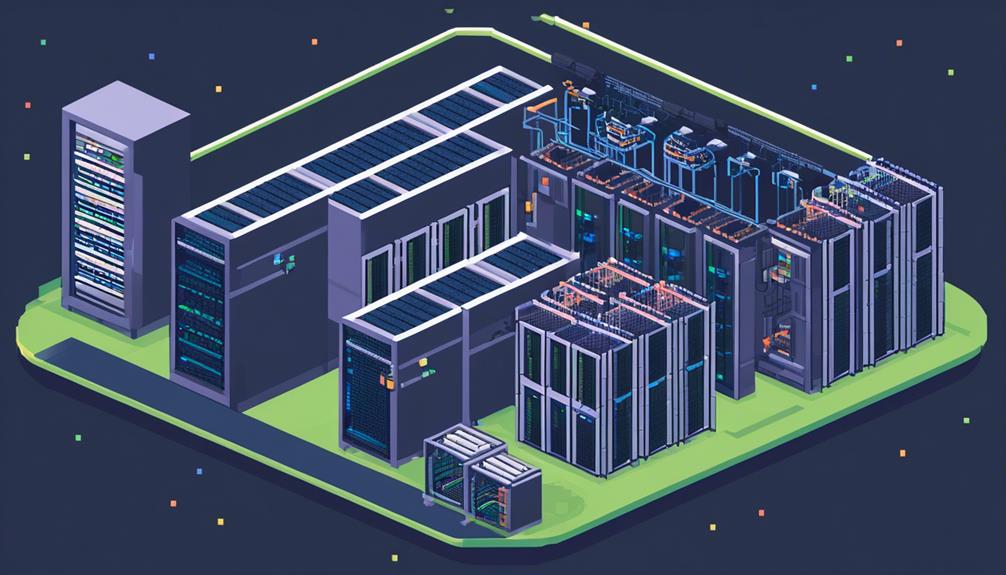
Optimizing cooling systems in data centers is a crucial step towards achieving significant cost savings. With the increasing demand for data storage and processing capabilities, data centers consume a substantial amount of energy, and cooling systems play a vital role in maintaining optimal operating temperatures. Artificial intelligence (AI) has emerged as a powerful tool to optimize cooling systems, resulting in improved efficiency and reduced costs.
AI enables real-time dynamic optimization of cooling systems by intelligently managing cooling units to match the load they are serving. By using AI algorithms, data centers can reduce the speed of lightly loaded units and increase the effort of heavily loaded units. This load balancing approach helps in minimizing energy consumption, leading to substantial cost savings.
Moreover, AI algorithms can analyze complex data patterns and predict the cooling requirements of data centers. By continuously monitoring and adjusting cooling parameters, AI systems can ensure efficient cooling while minimizing energy wastage. This proactive approach not only reduces operational costs but also improves the overall performance and reliability of data center cooling systems.
Furthermore, AI can optimize cooling systems by considering various factors such as ambient temperature, humidity, and equipment configurations. By dynamically adjusting cooling parameters based on these factors, AI can ensure that cooling resources are utilized optimally, resulting in significant cost savings.
The Future of AI in Data Center Cooling
As data centers continue to evolve and adapt to the increasing demand for storage and processing capabilities, the future of AI in data center cooling holds immense potential for further optimizing energy consumption and operational efficiency.
AI enables dynamic optimization of data center cooling in real time, improving performance and operational cost efficiency. By using AI, data center operators can intuitively manage cooling units to match the load they are serving, reducing energy wastage and ensuring efficient cooling.
AI solutions for data center cooling also help in identifying sub-optimal equipment performance through real-time monitoring and power usage insights, allowing for proactive maintenance and maximizing the lifespan of cooling systems.
Moreover, AI's impact on sustainability goals aligns with the broader conversation about using AI to address environmental challenges in data center cooling.
Incorporating AI in data center cooling not only enhances energy efficiency and reduces operational costs but also presents several exciting possibilities for the future. Here are four key aspects that highlight the potential of AI in data center cooling optimization:
- Advanced Predictive Analytics: AI can use historical data and machine learning algorithms to predict cooling requirements accurately, enabling proactive adjustments to cooling systems and preventing unnecessary energy consumption.
- Autonomous Optimization: AI-powered systems can make real-time adjustments to cooling parameters based on environmental conditions, equipment performance, and workload demands, ensuring optimal cooling efficiency without human intervention.
- Edge Computing Integration: As edge computing becomes more prevalent, AI can play a crucial role in dynamically managing cooling at the edge, where traditional cooling infrastructure may be limited. This integration allows for efficient cooling in distributed data centers.
- Collaborative Optimization: AI can facilitate collaboration between multiple data centers by sharing insights and best practices, leading to collective optimization and further energy savings.
With industry leaders like Siemens and Huawei already developing and implementing AI-based cooling solutions, the future of AI in data center cooling is promising. The potential for energy savings, improved operational efficiency, and environmental sustainability makes AI an indispensable tool for optimizing data center cooling.
Real-World Examples of AI-Optimized Cooling Solutions
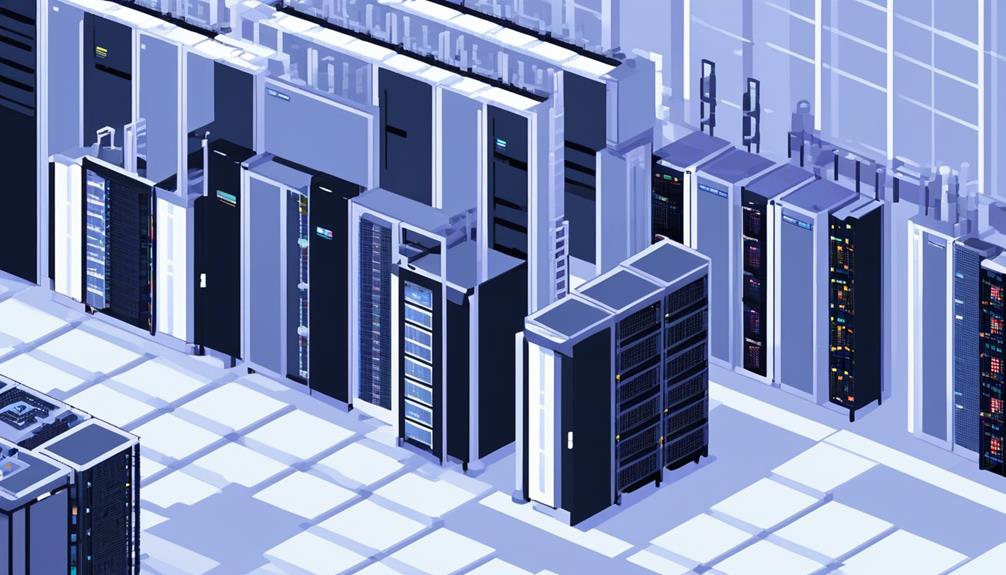
Several companies have successfully implemented AI-optimized cooling solutions in data centers, achieving significant energy savings and operational efficiency improvements. Siemens, for example, has developed an AI-based cooling system that adjusts cooling output in real-time to match the facility's needs. This dynamic approach ensures that cooling resources are allocated efficiently, resulting in reduced energy consumption and improved operational efficiency.
Similarly, Huawei's iCooling service utilizes deep learning algorithms to optimize cooling systems in data centers. By analyzing real-time data and historical patterns, the AI system intelligently adjusts cooling parameters to achieve maximum efficiency. This not only leads to energy savings but also contributes to sustainability goals by reducing the carbon footprint of data centers.
Studies have shown that AI in data center cooling can reduce energy consumption by around 30% on average. As AI algorithms continue to learn and improve over time, these energy savings are expected to increase even further.
Vigilent, another prominent player in the field, offers a dynamic cooling management system powered by supervised learning. This system has been deployed across more than 500 installations and has consistently delivered substantial energy savings.
AI-driven HVAC systems for data center cooling efficiency have the ability to adapt and optimize operations in real-time. By continuously monitoring and analyzing data, these systems can make precise adjustments to cooling parameters, resulting in significant energy savings and improved performance.
Frequently Asked Questions
How Artificial Intelligence Is Cooling Data Center Operations?
Artificial intelligence (AI) is revolutionizing data center cooling operations through the implementation of AI-powered predictive models and machine learning algorithms.
By analyzing historical data and real-time inputs, AI enables the identification of energy-efficient cooling techniques. This optimization process involves dynamically adjusting cooling unit settings to match the workload, reducing excessive cooling costs.
AI also ensures constant monitoring and quick notification of cooling issues, enabling proper temperature maintenance.
The adoption of AI in data centers provides significant benefits, including improved performance, cost reduction, and accurate future planning.
How Do You Optimize Data Center Cooling?
To optimize data center cooling, it is crucial to implement energy-efficient strategies that ensure optimal temperature maintenance without excessive cooling costs. This involves dynamically managing cooling units to match the load they serve, reducing the speed of lightly loaded units, and increasing the effort of heavily loaded ones.
How AI Can Help Data Centers?
AI applications in data center management are revolutionizing the industry by implementing AI algorithms for energy efficiency. These applications enable real-time optimization of data center environments, leading to improved performance and cost efficiency.
By intelligently managing cooling units to match the load they are serving, AI reduces energy consumption and costs. Constant monitoring and quick notification of cooling issues ensure proper temperature maintenance without excessive cooling costs.
AI adoption in data centers provides benefits such as real-time equipment efficiency maintenance and accurate future planning.
What Is the Most Efficient Cooling System for a Data Center?
The most efficient cooling system for a data center is one that combines advanced technology and energy-efficient methods. By utilizing cooling system comparisons, data centers can identify the optimal solution for their specific needs.
Energy-efficient cooling methods, such as air-side economizers, liquid cooling, and containment systems, can significantly reduce energy consumption and costs. These systems prioritize sustainability and minimize environmental impact while ensuring optimal performance and temperature control within the data center environment.
Such solutions are crucial for maintaining the reliability and efficiency of data centers in today's technology-driven world.
